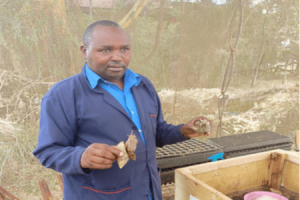
Dr Paul Kinoti at the JKUAT snail farm, where he is researching the potential of snail slime cough syrup. Credit: Wilson Odhiambo/IPS
By Wilson Odhiambo
NAIROBI, May 29 2023 – Snails and slime are usually followed by the thought ‘EEW!’ from most people … some might even scream at seeing a snail near them.
For Dr Paul Kinoti, however, these slimy creatures could earn him international recognition because his research on snails landed his institution, Jomo Kenyatta University of Agriculture and Technology (JKUAT), a Ksh. 127 million (USD 1 million) grant.
The grant, awarded by the Cherasco Institute of Snail Breeding, Italy, is expected to fund a two-phase research project to produce cough syrup meant for children under five.
As a lecturer at JKUAT’s Horticulture and Food Security department, Kinoti has specialized in non-conventional farming systems for over a decade.
Non-conventional farming is a system that employs modified/unique farming methods in crop and animal production. Kinoti has been researching insects and worms (vermiculture), concentrating on how they add value to supplement crop and livestock production.
According to Kinoti, snails are already associated with a wide variety of products, including animal feeds, skin care products, pharmaceuticals, and fertilizer.
“My research focuses on unique farming methods that farmers are not used to, including rearing insects and worms as a source of livestock feed and fertilizer for plants. I keep black soldier flies and worms which are a major source of proteins for livestock, especially for poultry and fish,” Kinoti explained to IPS.
And as a food security specialist, one of his goals is to encourage people to include snails in their diet, given that it is rich in proteins and iron.
“Lack of awareness is the main reason why Kenyans do not see snails as a source of food for themselves, and getting them to accept it will be a difficult task. This is why we are using a simpler approach by encouraging farmers to take up snail farming to get used to the idea of having snails around them,” he told IPS.
Across the globe, majorly in Asia, parts of Europe, and West Africa, snails are a known delicacy.
The snail products are currently being manufactured within JKUAT, where, through training, they have engaged local farmers to supply them with snail slime (mucin). The institution offers these farmers short, three-day courses on how to rear snails and extract their slime, which they later sell to the institution for profit.
“We are grateful to the institution for opening our minds to an opportunity that has become quite lucrative. Most of the people in Kiambu County are either full-time farmers or have a piece of land somewhere that they have put aside for farming activities, making this a good source of extra income. Snail farming is new to us. Most would never even have considered practicing it due to the culture that we have grown up with,” said Antony Njoroge, one of the local farmers who now farms snails.
During his PhD studies in Austria, Kinoti was introduced to snail farming by his host, a snail farmer.
“When I came back, I realized that snail farming was still alien to Kenya, and rather than just focus on rearing the snails, I decided to research their value addition for farming. It is from this that I was able to come up with different products such as fertilizer, animal feeds, and skin care products,” Kinoti told IPS. The products have been certified by the Kenya Bureau of Standards (KEBS) and are already in the market.
The idea for the cough syrup did not come about until 2019, when Kinoti conducted field research on snails in Kumasi, Ghana. His visit happened to be during the flu season, where he was surprised at the strange concoctions that parents were using as remedy for their children who were coughing.
“I noticed that rather than being given ginger or lemon tea that most of us are used to when someone gets the flu, their parents were collecting snail slime and mixing it with some bit of honey which they gave the children as a remedy,” Kinoti explained to IPS. This idea stuck in my mind, and when I came back, I decided to do more research on it.
The project’s first phase, which is meant to take two years, will involve identifying the best snail species for production and research on snail slime while encouraging farmers to breed them. The second phase will be manufacturing and producing the cough syrup once it has been approved by the Kenya Food and Drug Authority (KFDA).
The snail species commonly used for slime production is the African giant land snail (Achatina Fulica), which produces up to 4 milliliters of slime per snail. It takes about 250 of these giant snails to make a liter of slime, extracted once weekly.
The Achatina Fulica is native to East Africa, where its origin can be traced to Kenya and Tanzania. Across the globe, it is regarded as an invasive species due to its ability to produce colonies from a single female. It feeds in large quantities and is a carrier for plant pathogens, making it a pest to farmers when it invades their farms. It has spread across the globe through exportation to Europe and Asia as a delicacy, being bought into those areas as a pet or by accidental transportation when it latches on to something.
The project involves a number of experts (mainly within the university) from different departments to help oversee its success. These experts include animal scientists, food scientists, health scientists, and other technical staff who help run the snail farm.
It also works in conjunction with other major institutions such as the Kenya National Museum, whose work is to help them identify the best type of snails for slime production, and the Kenya Wildlife Service (KWS), which is the main stakeholder and body that provides them with the license they need to carry out snail farming in Kenya.
As a conservation measure, the snails are not supposed to be harmed during the slime extraction, which makes it a delicate process that involves using citric acid, and the extraction is only done once a week.
Once successful, the cough syrup is expected to help lower the cost of importation since everything will be manufactured locally, thus helping save a lot of money. The farmers are also excited that they no longer have to rely on expensive fertilizer and animal feeds from the government, which has always made their input expensive while giving them little returns.
As a delicacy, snails are primarily spotted in high-end hotels that are mostly visited by foreigners and tourists.
“Growing up, the one memory I had about snails from my biology lessons was that they caused bilharzia, which made me dislike them. Today, I am one of the suppliers of snail meat to some big hotels in Nairobi and Mombasa,” says Brian Wandera, a local businessman from Nairobi. “It is amazing what knowledge can do.”
“I buy the snails from the farmers in Kiambu and sell them to the hotels at a profit. Locally, Kenyans are yet to adopt snail meat as a source of food,” he added.
The grant is also expected to help empower women and the youth by providing them with employment opportunities through training on snail farming, according to Kinoti, an investment of Ksh. 20,000 (USD 190) can earn a snail farmer between Ksh. 50,000 (USD 450) and 100,000 (USD 950) monthly once the snails start to produce their slime, usually at four months. The slime is categorized into three grades which are sold at different prices.
“We buy the slime from the farmers at a fee of Ksh. 1200 (USD 11) per liter for grade A slime, Ksh. 850 (USD 8) per liter for grade B slime and Ksh. 650 (USD 6) for grade C slime,” Kinoti concluded.
IPS UN Bureau Report

